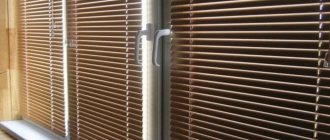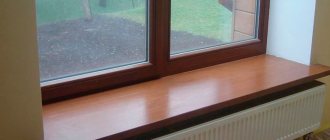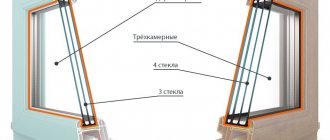Technologies for the production of building materials give builders a choice. You can diversify raw materials and create practical combinations of consumables.
Each of them has specific properties and qualities. The walls are erected from expanded clay concrete, aerated concrete, brick, reinforced concrete structures and others. Each raw material option has its own recommendations for use and methods of connecting the incoming elements to each other. Taking into account the modern relevance of PVC building structures, you need to know how to properly install plastic windows in aerated concrete walls.
How to determine the size of a window opening
The size of the window determines the amount of light entering the home. Naturally, the required level of illumination in auxiliary and living rooms is different.
There is no point in installing wide glazing in the pantry. And in bedrooms and living rooms it is better to install two- or three-hung windows.
A properly lit room
The area of the window unit is usually selected in proportion to the size of the room. Except for cases when the facade of the house should reflect a special author's idea.
The standards specified in GOST 23166-99 are used in the design of standard buildings. There are no such requirements for private construction. A person has the right to independently decide what type of glazing to use.
Installation of windows in an aerated concrete house
The process of installing a PVC window in an aerated concrete masonry opening consists of the following steps:
- cleaning the surface of the opening.
- leveling the window frame;
- marking the wall for drilling holes for dowels;
- direct driving of dowels;
- securing the window frame with self-tapping screws or plates;
- installation of protective tapes;
- filling the joints between the frame and the opening with polyurethane foam.
Window installation depth
If the wall is single-layer (made only of aerated concrete, without insulation and an additional structural layer), the windows are installed with a slight offset from the axis towards the external contour. The exact distance is usually determined as 1/3 of the thickness of the masonry. Accordingly, on a wall 350 mm thick, the distance from the front plane of the wall to the window will be approximately 11-12 cm.
If the wall from the outside will be insulated with mineral wool or expanded polystyrene, the windows are installed flush with the outer surface of the walls. And in order to prevent heat from escaping from the premises through the joints, when going around the opening from the outside, they are covered with heat-insulating boards, so that they form a quarter when installed.
Recommended reading
Adhesive foam for construction: cleaner, faster, cheaper
More details
Brick facing can also be installed using the same principle, which forms a quarter (and this is the best barrier to drafts). If the wall has three layers (aerated concrete-insulation-brick), the window can extend almost beyond the limits of the aerated concrete masonry and is installed opposite the heat-insulating layer. All these options are clearly shown in the diagram below.
Installing windows on plates
The use of plates as fastening elements is one of the methods used when installing oversized window or door units with low weight. It is more convenient to fasten the frame through them if the lintel above the window is not aerated concrete, but reinforced concrete.
If this particular installation method is chosen, the plates themselves are also added to the general list of necessary consumables. There are options designed for a specific profile system, which are supplied complete with windows. But more often universal plates without mounting lugs are used. They have perforations for nails, but since the frame is attached to dowels of a larger diameter, you will have to drill additional holes in the plates.
The number of plates depends on the size of the window. Fastenings are made horizontally and vertically at 15-20 cm from the corners of the frame, and then after 65-70 cm. When the frame is installed assembled with double-glazed windows, fastening with plates can only be done from the outside of the opening. If only the bare frame is installed first, the plates can be installed from the inside.
Installing windows on dowels
A dowel is a type of long metal fastener with threads used for fastening window and door frames in openings (usually 10*132 mm). Such fastenings are the most reliable; dowels are used when installing large blocks with an area of 3-4 m2.
Professional installers use this particular installation method, but an amateur installer with no experience can easily damage the structure by making a hole in the wrong place. As a result, the chamber in the frame will depressurize, begin to accumulate moisture and freeze in winter. The pins on a window with closed sashes are not visible at all, as is the case with plates, and this is an advantage of this installation method.
If there is a reinforced concrete lintel that makes it difficult to install dowels, the fastenings are combined - the top is fixed to plates, and the sides are fixed to dowels.
Sealing gaps
Plastic frames can be installed not only in new buildings, but also to replace old wooden windows. In any case, a gap of at least 3-4 cm is provided between the boundaries of the opening and the window itself, which will provide compensation for the thermal expansion of the frame. As the ambient temperature increases, the plastic lengthens; if there is no gap, the frame will rest against the masonry and become deformed, which is what needs to be avoided.
Gaps in the walls are direct cold bridges through which heat will escape if not sealed, so they need to be sealed. Polyurethane foam is used for this purpose. To ensure its adhesion to the surface of the aerated concrete masonry, the opening is cleared of dust and treated with a primer before installing the window.
Recommended reading
How to install doors in aerated concrete
More details
After filling the gaps, you need to wait until the foam hardens, its excess must be cut flush with the surfaces of the frame. To protect the foam layer from the destructive effects of ultraviolet radiation, the outside of the gap is sealed with self-expanding tape (PSUL).
If the gaps in the openings are too large or uneven, it will be impossible to seal them with PSUL tape. It’s easier then to cut and paste strips of polystyrene foam, and then plaster them, recessing the fiberglass mesh into the screed. You can aesthetically close the joints from the outside with decorative strips offered by window manufacturers, or use foam window frame elements.
Standard sizes of plastic windows according to GOST
GOST 23166-99 and GOST 11214-86 regulate the procedure for designing window openings and glazing units. The set of GOST standards provides complete knowledge for the correct and safe installation of windows.
Ready-made solution that does not require measurements
The table below shows the ratio of the dimensions of the mounting opening and the window that is installed in it.
According to the rules, it should be 3 centimeters smaller than the opening.
Such precision is necessary for an ideal foam seam, which will rid the home of drafts and extraneous noise from the street.
The following values are typical for the central European part of Russia:
Dimensions of double-hung windows:
In nearby regions, a correction factor is used:
- for the northern parts – 1.2;
- for southern ones - 0.75.
It is permissible for a design bureau to carry out calculations in accordance with GOST. In other cases, you can use average values.
The standard sizes of three-leaf plastic windows for a private home have characteristic features. They are quite wide.
The crossbar above the opening must be of sufficient strength. Otherwise, the loads may compress the window frame and the window will crack.
Panoramic lighting is less complicated to calculate. And there are no requirements for its size. It is only necessary to perform the technical part with high quality, namely to select the thickness of the glass and install it correctly.
How to calculate window size
Having familiarized yourself with the theoretical part, you can begin to practice.
When designing technical documentation and a private house project, you should adhere to the following recommendations:
- It is better to place the window block at some distance from the wall.
- For rooms up to 3 meters wide, a window no more than one meter wide, located in the center of the room, is more suitable.
- A lintel must be left above the opening. The glazing should not extend beyond the ceiling part (with the exception of panoramic windows).
If the house has already been built, but you want to replace the window, you should think through and calculate everything in advance. Some openings can be closed, others can be moved. This way you can correct most of the mistakes of the last century and create an atmosphere in your home.
A double-leaf window without a mullion looks good in a private home
Window openings must be measured from the inside and outside. Then the data is summed up and an average is output, which is used to select a window block.
It is impossible to install a PVC profile “centimeter by centimeter”. It is necessary to leave a technical gap of 2-4 cm. After installation, it is blown in with foam and becomes a compensator for thermal expansion.
On the street side, it is necessary to leave space for installing ebb tides. Otherwise, after the first rains, moisture will appear inside the room.
When to install windows in an aerated concrete house
There is an opinion that due to the shrinkage of houses built from aerated concrete, windows can be installed in them no earlier than after a year. People who claim this simply confuse the concept of wall shrinkage with foundation settlement, which inevitably occurs due to additional compaction of the soil under the weight of the building erected on it.
- Masonry made from autoclaved aerated concrete blocks shrinks by no more than 0.5 mm/m due to the loss of initial moisture. This is a very low value that cannot in any way affect the integrity of the frames, and the installation time does not depend on it. There are other nuances that are taken into account.
- Most often, in private construction, windows are installed immediately after the construction of the frame of the house is completed. Taking into account the time spent on installing the roof and ceilings, it turns out to be about two months after the masonry of the walls is completed.
We recommend reading
Ventilation (airing) is an engineering system, thanks to which the continuous circulation of air masses in a room is organized.
More details
- Construction usually begins in the spring: the foundation and walls are finished by autumn, so they try to install windows as soon as possible to protect the building from rain and snow. Windows really protect against external moisture. However, aerated concrete walls, first of all, must get rid of internal moisture, and windows will only get in the way.
- Ideally, you should first perform rough plastering in the premises, leaving only the slopes of the openings untouched. When the screed is dry, you can install windows and continue interior finishing work.
- This approach will enable the gas-block masonry to shed some of the initial moisture before the onset of winter, and builders will be able to quickly begin finishing the façade. If winter has already arrived and you haven’t had time to carry out internal plastering, it is better to line the walls in the rooms with plasterboard.
Vitaly Kudryashov
Builder Author of the portal full-houses.ru
Ask a Question
As for PVC windows, they are not afraid of high humidity and can be installed before wet work begins inside the house. Excess moisture can condense on the surface of the double-glazed windows and then be absorbed into the surfaces of the slopes - and not far from the appearance of mold. This is another reason why it is better to install windows after internal plastering. If it is not possible to maintain this order, you need to provide the premises with heating and good ventilation.
The optimal number of windows in one room
Calculating the amount of natural light in your home is easy. You can be guided by the shape of the room.
For wide rooms, it is advisable to install 2 windows, clearly centered on the front wall. If you install windows at the edges, the center will be darkened, and with an opening in the center, the corners will not be illuminated.
A good solution for a spacious home
For a private house made of aerated concrete, it is ideal to install two windows located on two different facades. In this way, maximum light occupancy can be achieved at any daytime.
Watch the video: installing double-glazed windows in a house made of aerated concrete.
When planning your kitchen, you can experiment and install panoramic windows above the cooking area. And if you install the countertop correctly, the size of the usable area will completely increase.
Installing windows on dowels (unpacking)
This method of fastening windows is complicated in that before installation the frame must be completely disassembled, that is, all sashes must be removed. Next, alignment and fixation is carried out across the entire profile with long stainless self-tapping screws (metal dowels). The distance between the dowels should be about 40 cm.
The unpacking method is most often used for installing large windows with an area of more than 4 meters.
After installing the profile, the entire window system is assembled and adjusted again.
Calculation of the size of the hole for the window block
When measuring window blocks and designing openings, it is necessary to understand that the glazing will be smaller than the opening itself.
For wooden windows, it is absolutely necessary to leave space for the casing and window sill. For them, the opening should be 14 centimeters larger than the frame.
Window opening in a house under construction.
When accurately forming a window opening, all factors are taken into account, including the foam seam and the installation of a window sill with ebb. For the latter, the frame is shifted 10-15 centimeters into the room. Otherwise, when precipitation falls, the ebb tide will make a lot of noise.
The large difference between the opening and the wooden frame is necessary to compensate for the wood warping that will occur after installation, as well as the settlement of the support beam.
From the inside, the window is placed at a height of about one meter. Then you can lean on the mounted window sill and use its area as an auxiliary one.
Construction of window openings
When arranging openings in a house under construction, it is necessary to take into account the material of the walls and their manufacturing technology in order to maintain the design dimensions.
In brick houses
In brick houses, openings are often made with a quarter, arranging small protrusions of 5-6 cm (a quarter of a brick) on the outside of the walls on either side. These protrusions prevent frames from falling out, reduce cold bridges and eliminate the need to finish external slopes.
Diagram of an opening with a quarter and a window in section Source lisichansk.com.ua
As can be seen in the diagram, the internal clearance of the opening is larger than the external one, so the width of the window must be sufficient for the frame to rest against the outer side ledges. The support strip is 2-3 cm on each side and 1.5-2 cm on top. The lower plane of the frame, on the contrary, is raised 2 cm from the bottom of the opening so that from the street side it is possible to arrange an ebb with a slope.
In block houses
When installing window openings in walls made of foam concrete or gas silicate blocks, it is necessary to take into account their dimensions and position in the masonry:
- The side walls of the openings should not be located in line with the vertical seams.
- The height of the opening is limited from above by entire rows of blocks, since a lintel is laid on them. It can be increased from below by cutting blocks.
If the facade will be faced with bricks with quarters, they must be taken into account when calculating the size of the opening. In other cases, it is made 2-5 cm larger than the intended window on each side, which are necessary for installation seams.
Diagram of an opening without a quarter Source prorab.guru
Window location
When designing window openings in a new building, it is advisable to think in advance about the placement of furniture in the room.
This is especially true for kitchen areas, when a suddenly installed refrigerator can cover the window unit and reduce the amount of natural light in the kitchen.
In the kitchen, it is better to place windows at a height of 80-90 centimeters, ideally at the same level as the future kitchen unit. Then it will be possible to increase the working area due to the window sill.
The same height is suitable for other rooms in the house. It will provide a comfortable view for both a standing and a sitting person.
Instructions for installing a large window on plates:
- A hole for the dowel is drilled in the plates.
- The plates are secured to the window frame with two short self-tapping screws.
- The number of plates used is usually from 4 to 6 pieces or more.
- The window is installed and leveled using stands.
- The plates are pressed and a hole for the dowel is drilled through their holes using a hammerless drill.
- All dowels and screws in them are screwed in.
- The space between the frame and the wall is filled with high-quality polyurethane foam. It is desirable that the gap is about a centimeter, for convenient filling with foam and its economical consumption.
- Excess foam is cut off.
- Next, the window sill and internal slopes are installed.
If the window is small, the plates can be secured with ordinary self-tapping screws, without using dowels, since the main load will be supported by the mounting foam.
How to choose plastic or wooden windows for a private home
When choosing plastic or wood, first of all pay attention to the price. If the construction budget is limited, then it is always better to contact PVC window suppliers and purchase glazing from them. But if money plays a secondary role, then you can choose.
Wooden windows fit perfectly into any interior. They are easy to paint and thus change their design.
No chemicals are used in the manufacture of wooden windows, and therefore they are environmentally friendly. Plastic profiles also do not emit harmful substances, but they are not particularly environmentally friendly in production.
When choosing wooden windows, you need to know that not all wood is suitable for our climate.
In the Russian Federation, mahogany is valued, but larch and oak are also used. Caring for such products is not difficult, especially if done in a timely manner.
The wood is sanded and varnished or painted. This operation should be repeated every 5-6 years, depending on the climatic conditions of the region.
Installing windows on plates
This method is quite simple and suitable for people without much experience in construction. Suitable for small and medium windows. The window is secured using stainless steel anchor plates 40x160x2 mm. It is secured in aerated concrete with dowels and self-tapping screws (6×60 mm).
Before installing the window, you need to make insulated external slopes 20 mm thick from EPS. This will reduce the freezing depth of the slope, which will shift the dew point outward, eliminating excess condensation and mold.
If you want to get acquainted with the assortment of various plastic windows from the best manufacturers, we recommend that you find both budget and high-class windows there.
Panoramic glazing
An excellent type of glazing that came to us from France. Thanks to the large glass area, the entire room is filled with sunlight. The size of a panoramic window in a private house can be up to 80% of the wall.
See the link for house projects with panoramic windows.
Panoramic glazing is divided into 2 types: cold and warm.
The first is frameless glazing, when solid glass panels are attached to the base, but the seams are not sealed with anything. This type is suitable for an attic or loggia, but not for a living room.
For your home, you need to choose a warm glazing option. Then panoramic windows will become reliable protection from winds and precipitation outside.
Advantages of panoramic glazing:
- Increasing daylight hours.
- Maximum filling of the room with natural light.
- Decoration of rooms and landscape.
- A wide range of products allows you to choose products according to your budget and wishes.
Justification of standards
Window openings perform many functions. Through them, natural light and fresh air penetrate into the rooms, they allow you not to feel locked in a confined space, uniting it with the outside world.
However, windows must provide normal thermal insulation and be a reliable barrier to noise from the street, otherwise a comfortable stay in the house will be impossible. The appearance of the building and its visual perception are also of considerable importance.
For reference! The facades of residential buildings look harmonious when their glazing area is 40-50%.
Accepted standards, the main one of which is GOST 11214-86, take into account all these requirements and determine the optimal window sizes depending on the following factors:
- purpose of the premises, purpose of its use;
- room area;
- dimensions of the building as a whole;
- geographical and climatic features of the location of the house;
- wall material;
- technical characteristics of a double-glazed window (material of manufacture, glass thickness, number of glasses), on which its light transmittance depends.
The sizes, shapes and designs of windows should be determined at the stage of designing a house Source okna-forte.ru
Standardization greatly facilitates the design of high-rise buildings, townhouses and standard country houses, allowing you to do without additional calculations. Moreover, it allows for some deviations from the norms, making it possible to vary in one direction or another. For example, in the already mentioned GOST, the standard window height can vary from 116 cm to 206 cm, and the width from 87 cm to 267 cm.
A private developer cannot be required to comply with these requirements. But for the sake of your own comfort, positive emotional background and aesthetic satisfaction, it is advisable to understand how to correctly calculate the size of window openings and place them relative to other structures.
Window area
In order for the room to be properly lit and not require the use of artificial light during the day, the glazing area must be at least 0.03 m² for each cubic meter of its volume. There are also simpler and more understandable standards that require that the area of the window be no more than 6-8 times less than the area of the room it illuminates. In other words, the proportional ratio of areas should be in the range of 1:6 – 1:8. Or the window clearance should be 13-16% of the total area.
The optimal window size for a 20-meter room is 2.5-3 m² Source oknabm.ru
In this case, the maximum proportions are used when the windows face the sunny side and are not blocked by trees or other buildings. And vice versa.
Note! The larger the area of solid glazing without sashes, the thicker the glass should be.
The indicated values do not apply everywhere, but only in certain geographical latitudes. They are relevant within the range from 45° northern latitude, where cities such as Krasnodar and Simferopol are located, to 60° of the same latitude (St. Petersburg, Vologda).
This is a strip from St. Petersburg to Kyiv in the west and from Magadan to Komsomolsk-on-Amur in the east Source rossiikarta.ru
See also: Catalog of house projects with panoramic windows.
In other regions, an increasing or decreasing coefficient is used:
- North of the 60th parallel – 1.2.
- South of the 45th parallel – 0.75.
Based on the fact that the size of window openings in northern latitudes, according to all standards, should be larger than in southern latitudes, the problem of heat conservation arises. It is solved by increasing the glass in the double-glazed unit and the air chambers in the window profile. In regions with a warm climate, a single double-glazed window is sufficient, but in the northern regions it is better to use double or triple glazing.
Here it should be clarified that a two-chamber double-glazed window consists of 3 glasses and 2 air chambers, and a three-chamber double-glazed window consists of 4 glasses and 3 chambers. And each glass increases the refraction of light, which negatively affects its penetration into the room. Therefore, it is also advisable to take this parameter into account.
Single and double glazed windows Source 4okna.ua
These standards allow you to calculate the window opening for living rooms, but they are not required for bathrooms, storage rooms, verandas or terraces, where the windows can be much smaller or larger.
Location of openings
The location of window openings on the wall is also of great importance for the psychological comfort of people and the ergonomic use of space. If we talk about the distance from the window sill to the floor, then it differs for rooms for different purposes:
- living quarters - 80 cm;
- kitchens – 90 cm;
- bathrooms – 130 cm;
- attic – 100 cm.
However, such gradation has a bad effect on the appearance of the facade, so they try to level the level of openings on one floor. An exception is made for bathrooms, toilets, boiler rooms and other utility rooms, for which the possibility of ventilation is more important than the level of illumination.
The location of windows on the facade also needs to be taken into account Source oknaveka.com
Since the height of the window is important for the aesthetics of the facade, when calculating its optimal area, they “play” with the width. But even here there are some restrictions regarding the distance from the internal walls: the opening should not be located close to them. It is recommended to make a minimum indent of at least half a meter. Ideally, the window is placed exactly in the center of the front wall.
See also: Catalog of companies that specialize in working with doors and windows.
The influence of the type of windows on their sizes
When discussing the size of the window and the standard of illumination, we must not forget that the opening is partially blocked by frames and sashes. Their parameters vary depending on the design, strength, and material of manufacture.
Professionals involved in the manufacture and installation of windows are well versed in what the thickness and width of the frame profile should be, the layout of the frames for an opening of a given size, how many sashes can be made to open and how many to be blind.
Standards for the production of plastic windows
Modern plastic windows can be very different. Technologically, nothing prevents the manufacturer from producing window structures of any size and shape. But here, too, there are certain rules that should not be neglected.
So, in the pivoting casements of a plastic window, the height should be several times greater than the width. For tilt-type opening sashes, on the contrary, it is important to choose a width greater than the height of the window. Blind sashes, as we said above, are not recommended to be made larger than 1000 square meters. mm, to avoid glass breakage.
Although there is an expression among manufacturers of plastic windows that non-standard windows have long become a standard, the implementation of structures for windows that do not comply with GOST requires special precision and thorough elaboration. Therefore, when ordering such windows, be prepared for the fact that their cost will be noticeably higher than standard models.
Standards for window openings in apartments
Typical window sizes in multi-story buildings depend on the series of the house. Let's look at the most common options.
Old fund
This is the name given to houses built at the beginning of the 20th century, before the revolution. They are distinguished by thick walls, spacious rooms and corridors, high ceilings and, as a result, high window openings.
A standard single-leaf window in the old building can have dimensions of 115x190 cm or 85x115 cm.
Double-leaf structures can be presented in one of three options: 115x190 cm, 130x220 cm or 150x190 cm.
The three-leaf windows in the old building are of the same type - 240x210 cm.
Stalin-type houses (Stalinka)
Buildings built between the 1930s and 1960s are usually very beautiful in appearance. They are distinguished by strict architecture, high ceilings, large rooms and kitchens. Such houses were built from brick, the outside was lined with granite or plastered, and stucco molding and bas-reliefs were often used.
Due to the large size of the rooms, single-leaf windows were not used in Stalin buildings. The double-leaf ones were made in two versions - 115x195 cm and 150x190 cm, the three-leaf ones - 170x190 cm.
Khrushchev buildings
Model homes built from the 1950s to 1985. They can be made of panels or bricks, have low ceilings, poor sound insulation, and small interior spaces. From the outside, Khrushchev buildings look the same - with flat roofs and no decorations on the facade. In height - from 3 to 5 floors.
The size of the window opening in Khrushchev-era buildings can be determined by the width of the window sill. In brick houses with wide window sills, according to the standard, a double-leaf window should be 145x150 cm, a three-leaf window - 204x150 cm. In panel houses where the window sills are narrow, the opening sizes will be 130x135 cm and 204x135 cm, respectively.
Brezhnevka
These are apartments with an improved layout, more spacious than the housing of the Khrushchev period. Houses can reach 9 floors, and are always equipped with elevators and garbage chutes.
There are several series of Brezhnevkas, the typical window sizes in each of them vary.
- In the 602 series, a double-leaf window should have a size of 145x121 cm; a three-leaf window should have a size of 210x145 cm.
- In the 606 series, the opening for a double-leaf window is 145x141 cm, and 170x141 cm for a three-leaf window.
- The 600 series is characterized by large window openings. According to the standard, a three-leaf window in such a house could be 238x113, 238x142 or 269x142 cm.
Typical new buildings
Modern new buildings are very diverse. There are about 40 series of such houses, and the typical sizes of window openings for each of them are individual. Here are the most common sizes in centimeters.
- 504 - double-leaf 145x141, three-leaf 170x141.
- 137 - double-leaf 115x142, three-leaf 170x142.
- 504D - double-leaf 142x110, three-leaf 142x203.
- 505 - double-leaf 141x145, three-leaf 141x203.
- 600 - three-leaf 142x268, 110x236 or 142x236.
- 600.11 - double-leaf 141x145, three-leaf 141x205.
- 606 - double-leaf 141x145, three-leaf 141x170.
The above data can be used to roughly calculate the cost of glazing an apartment or house. There are often cases when, even in the same house, window sizes may differ from each other and from GOST requirements by 10-15 cm. Most often this is observed in panel houses. Therefore, to calculate the exact price of a plastic window, it is better to call a measurer. But standard sizes will help you navigate future costs.
Door and window lintels
Our aerated concrete house is growing, we are approaching the lintels. We need them to strengthen the wall above the door or window opening so that further construction does not collapse. They can be done in several ways:
- order ready-made. There are ready-made lintels on sale, and there are prepared formworks, so-called U-shaped blocks, that can be used for these purposes. They glued the required length, put it in place, laid the reinforcement, and filled it with cement. But they need to be ordered separately.
- make formwork from blocks yourself. To do this you will need blocks 100 mm wide. They stick together very well with the same glue. Such a jumper must be supported so that the cement poured inside does not break it. If there is no place to order “tens”, you can cut an ordinary block lengthwise into three parts.
Door lintel.
- build a jumper from ordinary blocks. The blocks were glued together, three longitudinal ditches were made, reinforcement was laid, and they were filled with cement-sand mortar. Leave it alone until the solution has completely set (about a day). It must be installed with the fittings facing down. But such lintels are only suitable for narrow openings (no more than 1 m), since the shift of the block relative to the previous row must be at least 8 cm.
Jumper made of blocks and reinforcement.
First, we put the jumper in its place, and then we fill in the gaps with gas blocks of the required size.
Lintels over windows.










